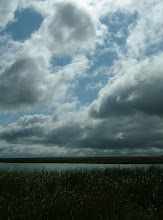 The railings around the stair opening and around the 'loft' openings are complete!
The railings around the stair opening and around the 'loft' openings are complete!  This means my fear of heights, my panicky moments when someone steps too close to the openings or worse, when I myself step too close to the openings, can finally be laid to rest.
This means my fear of heights, my panicky moments when someone steps too close to the openings or worse, when I myself step too close to the openings, can finally be laid to rest.  The top and bottom rails are of 2" x 6" pine from the timber framer so that it matches the frame.
The top and bottom rails are of 2" x 6" pine from the timber framer so that it matches the frame.  The spindles are 1/2" iron with a couple of twists. These were ordered raw wrought iron and cleaned with WD-40 oil and then coated with a tung oil finish. One batch was left outdoors last summer to test the effectiveness of the finish, and they remained rust free after a couple rains and a few weeks time.
The spindles are 1/2" iron with a couple of twists. These were ordered raw wrought iron and cleaned with WD-40 oil and then coated with a tung oil finish. One batch was left outdoors last summer to test the effectiveness of the finish, and they remained rust free after a couple rains and a few weeks time. 


This leaves the following remaining: A bit of drywall patching where it was cut for access to the bathtub plumbing, priming of a couple walls, painting of those walls, trim priming and painting at the edges of a few other walls, laying of the prefinished flooring on all of the second floor except the bathroom, baseboard, installation of bathroom door, grout on the slate tile floors in bathrooms and first floor hallway, tile and grout in shower and bathtub areas, shower and bathtub glass doors, and the glass panels from the top of the bathroom walls to the ceiling rafters.

2 comments:
I stumbled upon this post, and absolutely love the woodwork/wrought iron combo. Did you do the work yourself? If so can you give a brief explanation on the banister and stairwell assembly. Thanks in advance!
Jered
I found the iron spindles online on a closeout. They were raw iron and the company was only going to sell painted ones from then on. I have lost the name of the company but you can search for wrought iron railing spindles. If you can find raw unpainted, they will need a finish to prevent rust. I used a brass brush to clean off rust that was there and brushed on Tung Oil. Danish Oil also works.
My husband and son built the railings. The bottom rail is a 2" x 6" pine board and the top rails is the same. Where it is stair railing, the top rail is routered with a groove 1/2" x 1/2" approximately, according to our local building code that requires a 'handrail' and not just a big flat board there. The routered groove makes the top edge be that handrail. They drilled round holes in the bottom rail and the top rail somewhat smaller than the size of the spindles so that the spindles would bite into the holes when pounded in. The spindles were pounded into the bottom rail and the top rail was lowered down onto them from one end. It helps to have a few people at this point, one to hold the top rail up, one to hold it down at the starting end, and at least one more to move along and feed the spindles into the top rail. Use a cloth on top of the top rail if you have to pound on it to get it to seat so that the blows don't leave marks. Of course, where used as a stair rail, the holes need to be upright as the railing goes at an angle. They used a drilling jig for those angled hole.
Post a Comment